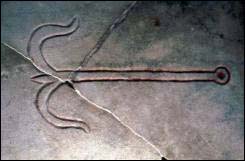Since the Pope and the Vatican have quite a lot of fence-mending to do with the art world, in many ways, this was an interesting development. (Check out Edward Winkleman's comments too on the Pope's speech.) Whilst the Pope's announcement that the Vatican will participate in the 2011 Venice Biennale is a clear signal of involvement in the contemporary art scene, his speech seemed to dwell more on "beauty" and its potential pathway to the "transcendent". In some ways, his words resonate when he said, "In a world lacking in hope, with increasing signs of aggression and despair, there is an ever greater need for a return to spirituality in art."
Benedict XVI also said, "What is capable of restoring enthusiasm and confidence, what can encourage the human spirit to rediscover its path, to raise its eyes to the horizon, to dream of a life worthy of its vocation - if not beauty?" Moreover, "the experience of beauty does not remove us from reality, on the contrary, it leads to a direct encounter with the daily reality of our lives, liberating it from darkness, transfiguring it, making it radiant and beautiful."
Wonderful words, hard to define really, let alone put into practice. Especially when the Pope also talked of "the beauty thrust on us is (too often) illusory and deceitful. It imprisons man within himself and further enslaves him, depriving him of hope and joy." Frankly, that is a passage that leaves me wondering who defines the Vatican's version of beauty. I don't know enough of present Vatican cultural politics. Does anyone else who is reading this ?
Nonetheless, I find it refreshing to see such a figure as the Pope talking of beauty and its central role in life, spiritually and culturally. Not so very long ago, particularly in the United States, the word, "beauty" was very much out of fashion in the art world. We are all impoverished when beauty, in its many, many forms and versions, is not part of our daily lives.




